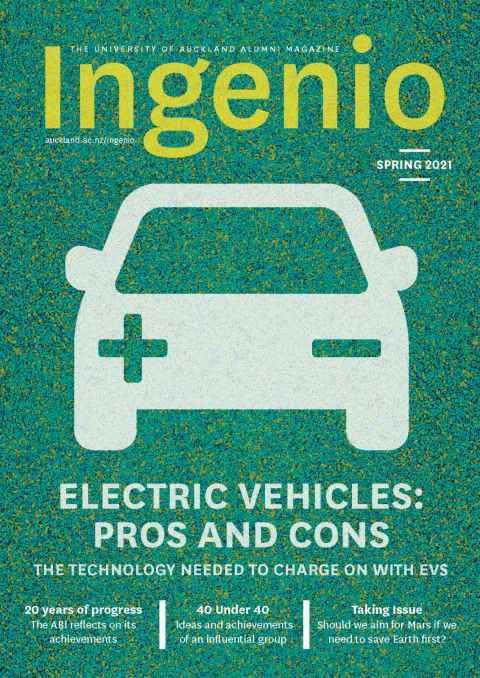Charging into the future: infrastructure vital to electric vehicles taking off
3 November 2021
Is New Zealand’s infrastructure ready for an increased uptake in electric vehicles? Experts at the University are helping devise the technology needed as well as working to remove barriers to access.
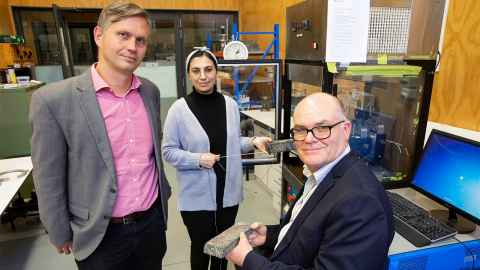
The fact that the Huntly Power Station has burned record amounts of imported coal in 2021 is but one indication that New Zealand is going in the wrong direction when it comes to meeting its international climate change commitments.
Transport accounts for 21 percent of New Zealand’s annual greenhouse gas emissions, so encouraging greater use of electric vehicles (EVs) to address the 90 percent rise in transport emissions over the past three decades could be a solution. But some say that more EVs will place additional load on an electricity network that’s already struggling to meet demand. Others fear that EVs could embed existing health inequities and potentially disadvantage Māori.
So, how is New Zealand preparing for any increased uptake in EVs? What technologies are we advancing, and what are the challenges and opportunities that lie ahead?
As the Lead Principal Investigator of the MBIE-funded Inductive Power Transfer (IPT) Roadway Project, University of Auckland Professor Grant Covic (Engineering) heads a multidisciplinary research team supported by the Robinson Research Institute at the Victoria University of Wellington and GNS Science, which aims to develop new ways to charge New Zealand’s EV fleet.
For many consumers, the greatest barrier, other than cost, is ‘range anxiety’, creating fear of either running out of power or having to break a journey to recharge. Which is why IPT is a potential game-changer. Enabling vehicles to charge wirelessly as they travel down a highway or top up while they’re parked at the supermarket not only increases range but also removes ‘plug-in anxiety’ and eliminates ‘charging deserts’.
The major task is to develop charging pads – connected to a reliable source of power – that can survive being embedded in the highway. They are described by the road pavement engineering fraternity as being akin to having ‘an alien in the pavement’.
Grant says the goal is to “break the technology barriers to get it into the road, with development starting within the next decade”.
The challenge for Professor Simon Bickerton (Engineering) and the team he leads at the Centre for Advanced Composite Materials is to develop a robust and cost-effective solution that optimises the life of the encapsulated ferrite ceramic pad and aligns it with the lifecycle of the pavement. “It’s about utilising materials to protect the delicate electrical equipment thermally and mechanically within the roadway.”
Heat is also “a real issue”, according to Dr Doug Wilson from the University of Auckland’s Transportation Research Centre, who says that polymers and additives may need to be added to the surrounding asphalt mix to stop it from becoming fluid and tacky.
“It’s a challenging project, but it’s also exciting because it provides lots of opportunities to look at innovative materials and techniques.”
Ease of maintenance and longevity is also critical. The last thing that road users want, says Doug, is more congestion caused by ripping up pavements.
“We want to ensure we are making good decisions now about a future transport system for the next 50 years. That’s a complex and difficult task, but it’s something that we really need to take on.”
It’s a big investment now for a city to put this sort of technology in and you don’t want to get it wrong.
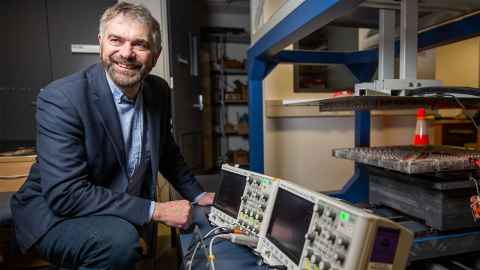
Testing the pavements
A demonstration system could be up and running within three years, and Doug is grateful for the support of industry players like Downer New Zealand. Downer has provided space and pavement construction expertise near its South Auckland asphalt plant for the development of a new accelerated pavement tester that will simulate a truck wheel running over a half-scale roading surface to fully test the electrical, mechanical and civil components.
Grant and the University’s power electronics group have been using their world-renowned IPT experience to develop global standards to pave the way for the universal acceptance of wireless charging. The ultimate goal is for power to be able to transfer between charging pads in the road and the pads in vehicles, regardless of whether it’s a Ferrari or a bus or how high the vehicle sits above the ground. Standards for light vehicles were introduced in 2020, with systems expected to become available in 2022. The focus now is on developing common technology for medium and heavy-duty vehicles.
The lead time from standardisation through to product development is normally around four years, and while China is advancing quickly, Grant says that wireless charging will eventually flow into New Zealand.
“We always seem to be the last stop even though we’re really leading the advancement of the technology.”
A lot of political decisions will need to be made, and he says that city councils and the government have a responsibility to think about how to proliferate charging infrastructure to ease the transition to EVs.
“It’s a big investment now for a city to put this sort of technology in and you don’t want to get it wrong,” says Grant.
Which raises the matter of cost, and who pays.
“It’s going to be an expensive system to initially install because it’s new technology skills and our construction sector is not really practised at being able to put these systems in,” says Doug.
People will most likely jump into the lane and pay the extra cost to use an EV charging lane service.

Cost of charging lanes
Economic modelling by the University of Auckland Business School suggests that IPT is viable, and Research Fellow Dr Selena Sheng says that public private partnerships (PPPs) may be the best option to attract private investors into such a huge infrastructure project.
At a consumer level, EV charging lanes would need to be tolled to recover the cost. Selena believes risk-averse motorists who want to reach their destination with sufficient battery power would pay.
“They will most likely jump into the lane and pay the extra cost to use this service.”
Engineering PhD student Pari Aghcheghloo is working on a MBIE Endeavour-funded project evaluating the performance of IPT pavement systems. “It’s such an important project to me because it’s essential we move towards more sustainable transportation systems,” Pari says.
“I envisage a world with widespread EV use and no air pollution from transport. Ultimately, this research will create better lives for people.”
For the heavy transport sector, the potential advantages of wireless charging are huge. As Simon puts it, “A smaller battery reduces the weight of the vehicle so it can carry more cargo – and it will also reduce battery costs.”
What’s more, charging times will be reduced, which minimises wait times at truck stops.
Ensuring fairness and equity is another important consideration and Grant says it has to be thought through in terms of policy.
“It’s a big question overseas. Nobody wants to have a situation where the rich get the benefit of new technology and people who are less well-off are seen to be driving dirty cars. That would not be a desirable outcome at all.”
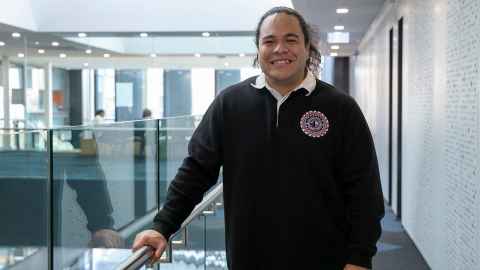
Using incentives like feebates to encourage EV uptake are all very well, but Doug says they also raise real equity issues between the haves and have-nots,“so we want to ensure that we provide opportunities in communities that don’t have a lot with perhaps more shared transport systems”.
That line of thinking extends to the Vision Mātauranga elements of the project, which involve understanding the needs and perspectives of Māori communities, including the holistic Māori world view that acknowledges the interconnectedness and interrelationship of all living and non-living things. The question for Doug is, “How can the technology of electrification and wireless power demonstrate to all of Aotearoa how to live more locally and share transport to reduce the carbon footprint?”
To that end, Faculty of Engineering lecturer Dr Tūmanako Fa’aui is researching the impacts, benefits and inclusion of Māori within the technology.
“The alignment in terms of sustainability outcomes and kaitiakitanga (guardianship) seems to be a key factor,” he says.
As is the case for many, the initial concerns around the cost of EVs and range anxiety apply for Māori. But there are potential opportunities to upgrade vehicle fleets for Māori businesses and organisations. Using natural resources owned by iwi, such as iron sands, in the construction of a wireless charging network could also generate revenue and “additional economic opportunities”, according to Tūmanako.
Wider conversations about health and community well-being are also on the agenda, along with better informing communities about the benefits of the technology.
“People don’t know what they don’t know,” says Tūmanako, so thought is being given to an education campaign in schools to “increase understanding of the technology and what’s possible even at that younger level”.
How can the technology of electrification and wireless power demonstrate to all of Aotearoa how to live more locally and share transport to reduce the carbon footprint?
Modelling is a key part of the IPT Roadway Project in terms of predicting the future electricity demand from EVs and understanding the impact that dedicated charging lanes will have on traffic flows and road safety.
Transportation modeller Dr Prakash Ranjitkar (Engineering) says installing wireless charging pads along the entire Auckland motorway network would be too expensive, so it’s a matter of determining what percentage needs to be electrified – and where.
“With minimum cost, can we accommodate all the different types of vehicles? That is what we are looking at.”
A number of different scenarios have been modelled based on Ministry of Transport predictions about how the uptake of EVs will evolve, but Prakash says that policy changes like the feebate scheme will have an impact and “maybe the scenario that we are predicting in ten years will come early”.
Understanding the various factors that drive uptake is also important, and current research suggests that education rather than income is the main factor. More than 30,000 EVs are now on the road, but that’s only about one percent of all light vehicles in the country.
“People with a certain level of education are more technically savvy and they’re fascinated by the technologies,” says Professor Basil Sharp, director of the Energy Centre at the University.
“That’s added to their willingness to uplift this new form of transport.”
Interestingly, research by the Business School has found a positive relationship between solar-panel availability in certain regions and EV uptake. Early adopters who first bought EVs several years back are also having a positive influence on those who buy them now – the so-called ‘peer effect’.
“They try out new things and then they showcase that this is workable, this is doable, and it is safe for other people to use this kind of transport mode,” says Selena.
A smaller battery reduces the weight of the vehicle so it can carry more cargo –
and it will also reduce battery costs.
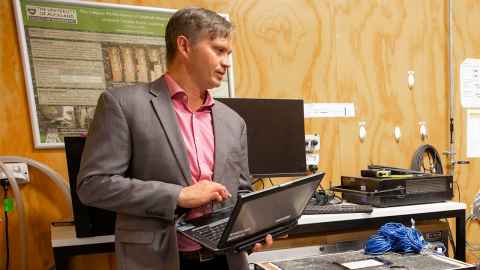
Transitional arrangements
Given the potentially long lead time before in-road dynamic wireless charging becomes a reality, thought needs to be applied to transitional arrangements such as fast-charging hubs in strategic locations – especially for commercial fleets – and the possible use of biofuels to further reduce greenhouse gas emissions.
Recent power blackouts are also a stark reminder that New Zealand must prepare for the increased load that EVs will place on the national grid. “We can’t just simply go and say, let’s all go electric,” says Grant.
“We’ve got to actually say, let’s also plan for an electrified transport technology.”
Rather than distributing energy over long distances at a higher cost, the IPT Roadway Project has highlighted the need to generate locally for transport purposes. Having solar or wind power that feeds directly into fast-charging systems is one option, and Doug says that strong leadership with a deep understanding of the problems is essential.
“We need to be making much smarter decisions about our infrastructure.”
The increased connectivity is also a huge opportunity for industry to grow around the electrification of transport, according to Grant.
“We can grow green energy sources in New Zealand and easily connect EV batteries to support the grid, taking energy when it is available during the day rather than waiting until nightfall and increasing the load on local transformers.”
Economics also suggests that as the technology becomes more available, it also becomes more affordable, as vehicle manufacturers scale up EV production.
“My attitude is that if there’s money to be made, the investment will follow,” says Basil. “But right now we’re burning coal in Huntly.”
While EVs will undoubtedly reduce New Zealand’s greenhouse gas emissions, Doug is quick to point out that ‘zero carbon electrification’ will never be a reality because of the embodied energy in the imported vehicles, which he says is not being accounted for.
Selena and Basil were among academics who recently published a paper comparing the energy mix that different battery EVs use to power the vehicles. It showed the reduction in CO2 emissions depends on the extent to which the vehicle’s electricity is generated from renewable sources. If fossil fuels are used in a car’s electricity generation, it could lead to a negative effect on the environment.
Then there’s the thorny question of battery production and disposal. The lithium-ion batteries found in most EVs are expensive to produce, heavy and only last between five and seven years. They’re also difficult to recycle, with most ending up in landfills or storage.
Solving the battery issue is not part of the IPT Roadway Project mandate, however Associate Professor Geoff Waterhouse (Faculty of Science) is working on a revolutionary solution to make EVs more efficient, affordable and environmentally friendly. Geoff and two post-doctoral fellows are midway through a three-year research project to create low-cost catalysts to enable the production of a zinc-air battery that can store six times more energy than lithium-ion batteries. The post-doctoral positions are funded by Kath and Greg Trounson, EV enthusiasts and donors to the University.
“Imagine having that same amount of energy stored in one-sixth of the volume,” says Geoff. “A further advantage will be that the air-breathing zinc-air batteries we’re developing are 100 percent recyclable.”
Another big advantage for battery manufacturers is that zinc is found in most countries around the world. This is in stark contrast to the current lithium-ion technologies, such as lithium-cobalt-oxide batteries, which are reliant on cobalt mined by child labour in Central Africa or the expensive lithium found mainly in Australia, South America and China.
Geoff and his team estimate that they are about four years away from something that they could take to a battery manufacturer, but that time could be halved with just one good idea.
“A lot of the commercial success that people have had in New Zealand can be distilled down to just one good idea with suitable IP protection as you go, as Grant Covic and John Boys did with inductive power transfer.
“If you work hard around that good idea, you can come away with a big win.”
Recognised along with Professor John Boys with the Prime Minister’s Science Prize in 2013 for his pioneering work on inductive power transfer, Grant hopes people will want to adopt EVs because it makes sense economically.
“The time for electric vehicles is now,” he says. “These technologies remove barriers and will make it easy. What we’re trying to do is to make the transition a lot smarter and a lot faster.”
The IPT Roadway Project is also forging new relationships and collaborations that Simon says are a “real exemplar” of multidisciplinary research.
“It’s about working together to solve what are often called wicked problems,” says Doug. “The wicked problem we have at the moment is the climate-change emergency.”
Story by Owen Poland
This article is the cover story in Ingenio magazine, the alumni publication of the University of Auckland. Email: ingenio@auckland.ac.nz
